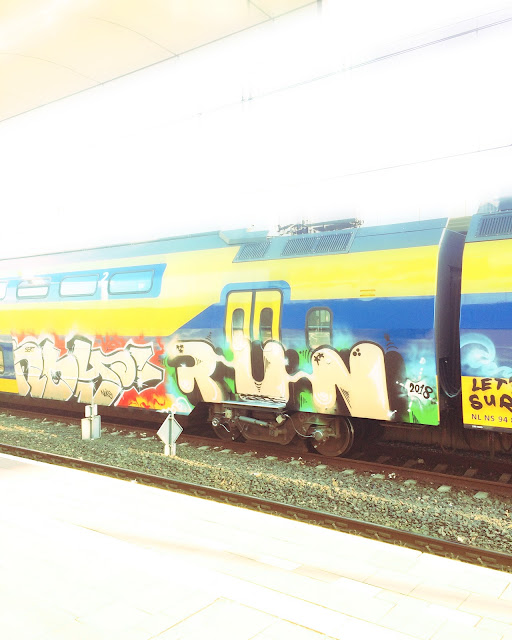Peter Waples-Crowe:
“I went on a trip to Asia early in the year and as I wandered around Thailand and Hong Kong I started to think about Aboriginality in a global perspective. This series of works are a response to feeling overwhelmed by globalisation, consumerism and celebrity.”
Source: Culture Victoria
'I want to be a proud, queer elder': Meet Aboriginal artist Peter Waples-Crowe (ABC News)
20 april 2018
Flood in the Forest
Culture Victoria:
This painting tells the story of how Woongies (Aboriginal People) used the forest in the flood time when there were still ceremonies held in certain areas. There was an abundance of food as animals would go to dry ground making them easier to be caught. There was plenty of fish and mouth-watering crayfish. The white figures are Mookies (spirits). It is the Yorta-Yorta belief that the Mookies are still there today.
ZETA THOMSON Yorta Yorta/Wurundjeri
This painting tells the story of how Woongies (Aboriginal People) used the forest in the flood time when there were still ceremonies held in certain areas. There was an abundance of food as animals would go to dry ground making them easier to be caught. There was plenty of fish and mouth-watering crayfish. The white figures are Mookies (spirits). It is the Yorta-Yorta belief that the Mookies are still there today.
ZETA THOMSON Yorta Yorta/Wurundjeri
Emu egg (dingo)
Culture Victoria:
Lindsay Kirby's artwork of Australian animals reflect both the traditional style of his Paakintji heritage and influences from Aboriginal artists of other regions.
LINDSAY KIRBY Paakintji/Yitti Yitti/Nyari Nyari/Wiradjuri
Lindsay Kirby's artwork of Australian animals reflect both the traditional style of his Paakintji heritage and influences from Aboriginal artists of other regions.
LINDSAY KIRBY Paakintji/Yitti Yitti/Nyari Nyari/Wiradjuri
Labels:
Australië,
beeldende kunst,
Victoria
Wiradjuri/Yorta Yorta
Culture Victoria:
Wiradjuri/Yorta Yorta
Born 1950, Balranald, New South Wales
Resides Kerang, Victoria
Esther began carving emu eggs in 1977 when her father Sam Kirby died. Sam Kirby was well known for his fine carving work and his ability to ‘do anything’ with the eggs. She had learned all his techniques by watching him and took up the carving to keep his name going. Esther’s common subjects are landscapes featuring figures and stories from Aboriginal mythology.
Amongst several other exhibitions, Esther’s work was included in the exhibition Women’s Work Land and Spirit at the 1995 International Women’s Conference in Beijing.
Wiradjuri/Yorta Yorta
Born 1950, Balranald, New South Wales
Resides Kerang, Victoria
Esther began carving emu eggs in 1977 when her father Sam Kirby died. Sam Kirby was well known for his fine carving work and his ability to ‘do anything’ with the eggs. She had learned all his techniques by watching him and took up the carving to keep his name going. Esther’s common subjects are landscapes featuring figures and stories from Aboriginal mythology.
Amongst several other exhibitions, Esther’s work was included in the exhibition Women’s Work Land and Spirit at the 1995 International Women’s Conference in Beijing.
Labels:
Australië,
beeldende kunst,
Victoria
Aboriginal man ornamented for a corroboree
Daintree, Richard, 1832-1878 & Antoine Fauchery, 1823-1861, photographers
Aboriginal man ornamented for a corroboree, standing, full face, whole-length
[ca. 1858]
Culture Victoria:
This image was taken by Antoine Fauchery and Richard Daintree between late 1857 and early 1859 for inclusion in their Photographic Series Sun Pictures of Victoria, The album consists of fifty albumen silver prints, twelve of which are photographs of Indigenous Victorians.
Cultural Warning: Aboriginal and Torres Strait Islander users of this website are warned that this story contains images of deceased persons and places that could cause sorrow.
Aboriginal man ornamented for a corroboree, standing, full face, whole-length
[ca. 1858]
Culture Victoria:
This image was taken by Antoine Fauchery and Richard Daintree between late 1857 and early 1859 for inclusion in their Photographic Series Sun Pictures of Victoria, The album consists of fifty albumen silver prints, twelve of which are photographs of Indigenous Victorians.
Cultural Warning: Aboriginal and Torres Strait Islander users of this website are warned that this story contains images of deceased persons and places that could cause sorrow.
Labels:
1858,
Australië,
fotografie,
geschiedenis,
Victoria
Abonneren op:
Reacties (Atom)













